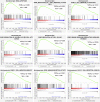Immune ULBP1 is Elevated in Colon Adenocarcinoma and Predicts Prognosis
- PMID: 35211154
- PMCID: PMC8862730
- DOI: 10.3389/fgene.2022.762514
Immune ULBP1 is Elevated in Colon Adenocarcinoma and Predicts Prognosis
Abstract
Background: Colon adenocarcinoma (COAD) is still the main cause of cancer deaths worldwide. Although immunotherapy has made progress in recent years, there is still a need to improve diagnosis, prognosis, and treatment tools. UL-16 binding protein 1 (ULBP1) is a ligand that activates the receptor natural killer cell group 2 receptor D (NKG2D) and plays an important immunomodulatory role. We aimed to investigate the clinical significance of ULBP1 in COAD. Methods: We obtained the relevant data from The Cancer Genome Atlas (TCGA). A total of 438 patients with COAD were included in this study, with a mean age of 67.1 ± 13.03 years old, of which 234 (53.42%) were male. The diagnostic value of COAD tumor tissues and adjacent tissues was analyzed by ROC curve. Univariate and multivariate survival analysis investigated the prognostic value of ULBP1 gene, and Gene Set Enrichment Analysis (GSEA) curve was performed to analyze the biological process and enriched enrichment pathway of ULBP1 in COAD. Combination survival analysis investigated the combined prognostic effect of prognostic genes. Results: ULBP1 gene had a high diagnostic value in COAD [AUC (TCGA) = 0.959; AUC (Guangxi) = 0.898]. Up-regulated ULBP1 gene of patients with COAD predicted a worse prognosis compared to those patients with down-regulated ULBP1 gene (Adjusted HR = 1.544, 95% CI = 1.020-2.337, p = 0.040). The GSEA showed that ULBP1 was involved in the apoptotic pathway and biological process of T cell mediated cytotoxicity, regulation of natural killer cell activation, and T cell mediated immunity of COAD. The combination survival analysis showed that the combination of high expression of ULBP1, AARS1, and DDIT3 would increase the 2.2-fold death risk of COAD when compared with those of low expression genes. Conclusion: The immune-related ULBP1 gene had diagnostic and prognostic value in COAD. The combination of ULBP1, AARS1, and DDIT3 genes could improve the prognostic prediction performance in COAD.
Keywords: COAD; GSEA; NKG2D; ULBP1; biomarker (BM).
Copyright © 2022 Ruan, Xie, Zhu, Ge, Yan, Liao, Gong and Shi.
Conflict of interest statement
The authors declare that the research was conducted in the absence of any commercial or financial relationships that could be construed as a potential conflict of interest.
Figures








Similar articles
-
Investigation and verification of the clinical significance and perspective of natural killer group 2 member D ligands in colon adenocarcinoma.Aging (Albany NY). 2021 Apr 27;13(9):12565-12586. doi: 10.18632/aging.202935. Epub 2021 Apr 27. Aging (Albany NY). 2021. PMID: 33909599 Free PMC article.
-
Diagnosis and prognostic value of C-X-C motif chemokine ligand 1 in colon adenocarcinoma based on The Cancer Genome Atlas and Guangxi cohort.J Cancer. 2021 Jul 25;12(18):5506-5518. doi: 10.7150/jca.51524. eCollection 2021. J Cancer. 2021. PMID: 34405013 Free PMC article.
-
Identification of DLL3-related genes affecting the prognosis of patients with colon adenocarcinoma.Front Genet. 2023 May 18;14:1098190. doi: 10.3389/fgene.2023.1098190. eCollection 2023. Front Genet. 2023. PMID: 37274780 Free PMC article.
-
Analysis of Interleukin-1 Signaling Alterations of Colon Adenocarcinoma Identified Implications for Immunotherapy.Front Immunol. 2021 Jul 23;12:665002. doi: 10.3389/fimmu.2021.665002. eCollection 2021. Front Immunol. 2021. PMID: 34367132 Free PMC article.
-
INSC Is Down-Regulated in Colon Cancer and Correlated to Immune Infiltration.Front Genet. 2022 May 19;13:821826. doi: 10.3389/fgene.2022.821826. eCollection 2022. Front Genet. 2022. PMID: 35664320 Free PMC article.
Cited by
-
FOXD1 expression-based prognostic model for uveal melanoma.Heliyon. 2023 Oct 23;9(11):e21333. doi: 10.1016/j.heliyon.2023.e21333. eCollection 2023 Nov. Heliyon. 2023. PMID: 38027647 Free PMC article.
-
Regulation of NKG2D Stress Ligands and Its Relevance in Cancer Progression.Cancers (Basel). 2022 May 9;14(9):2339. doi: 10.3390/cancers14092339. Cancers (Basel). 2022. PMID: 35565467 Free PMC article. Review.
-
UL16‑binding protein 1 is a significant prognostic and diagnostic marker for breast cancer.Oncol Lett. 2024 Oct 21;29(1):15. doi: 10.3892/ol.2024.14761. eCollection 2025 Jan. Oncol Lett. 2024. PMID: 39492940 Free PMC article.
-
NKG2D Fine-Tunes the Local Inflammatory Response in Colorectal Cancer.Cancers (Basel). 2023 Mar 16;15(6):1792. doi: 10.3390/cancers15061792. Cancers (Basel). 2023. PMID: 36980678 Free PMC article.
-
Analysis of differences in intestinal flora associated with different BMI status in colorectal cancer patients.J Transl Med. 2024 Feb 9;22(1):142. doi: 10.1186/s12967-024-04903-7. J Transl Med. 2024. PMID: 38331839 Free PMC article.
References
-
- Castriconi R., Cantoni C., Della Chiesa M., Vitale M., Marcenaro E., Conte R., et al. (2003). Transforming Growth Factor 1 Inhibits Expression of NKp30 and NKG2D Receptors: Consequences for the NK-Mediated Killing of Dendritic Cells. Proc. Natl. Acad. Sci. 100 (7), 4120–4125. 10.1073/pnas.0730640100 - DOI - PMC - PubMed
LinkOut - more resources
Full Text Sources
Research Materials

